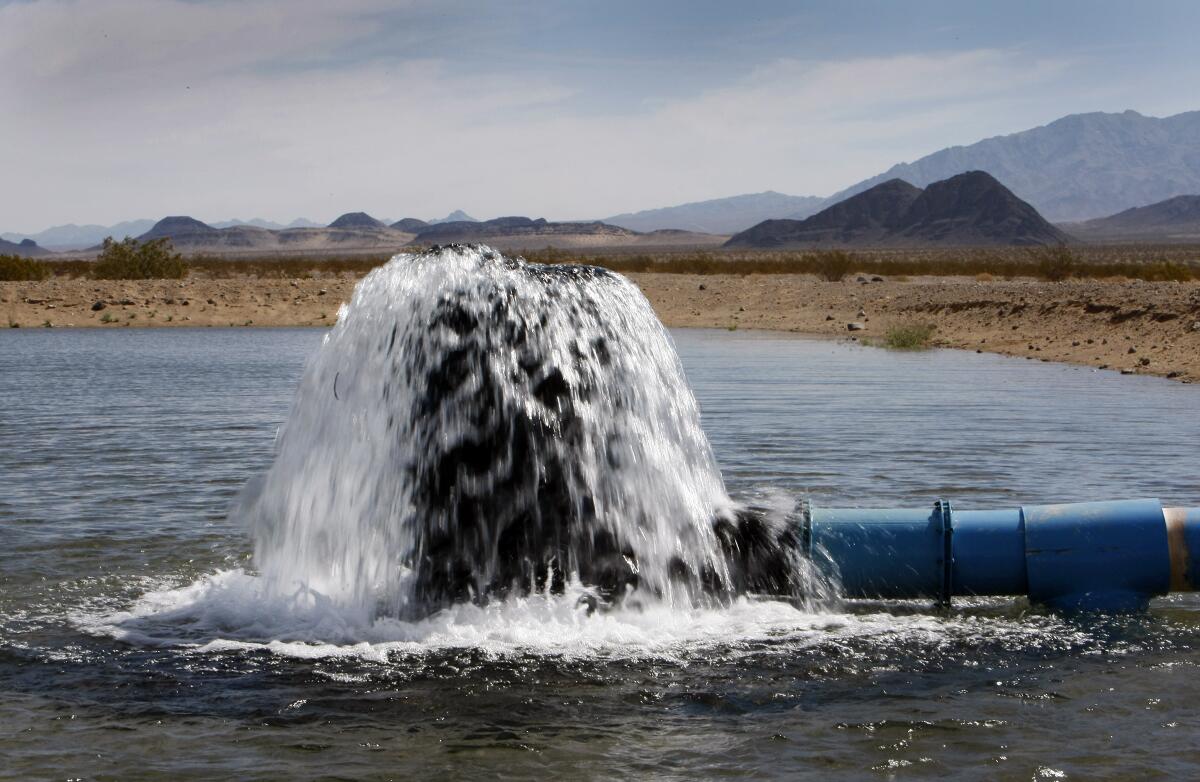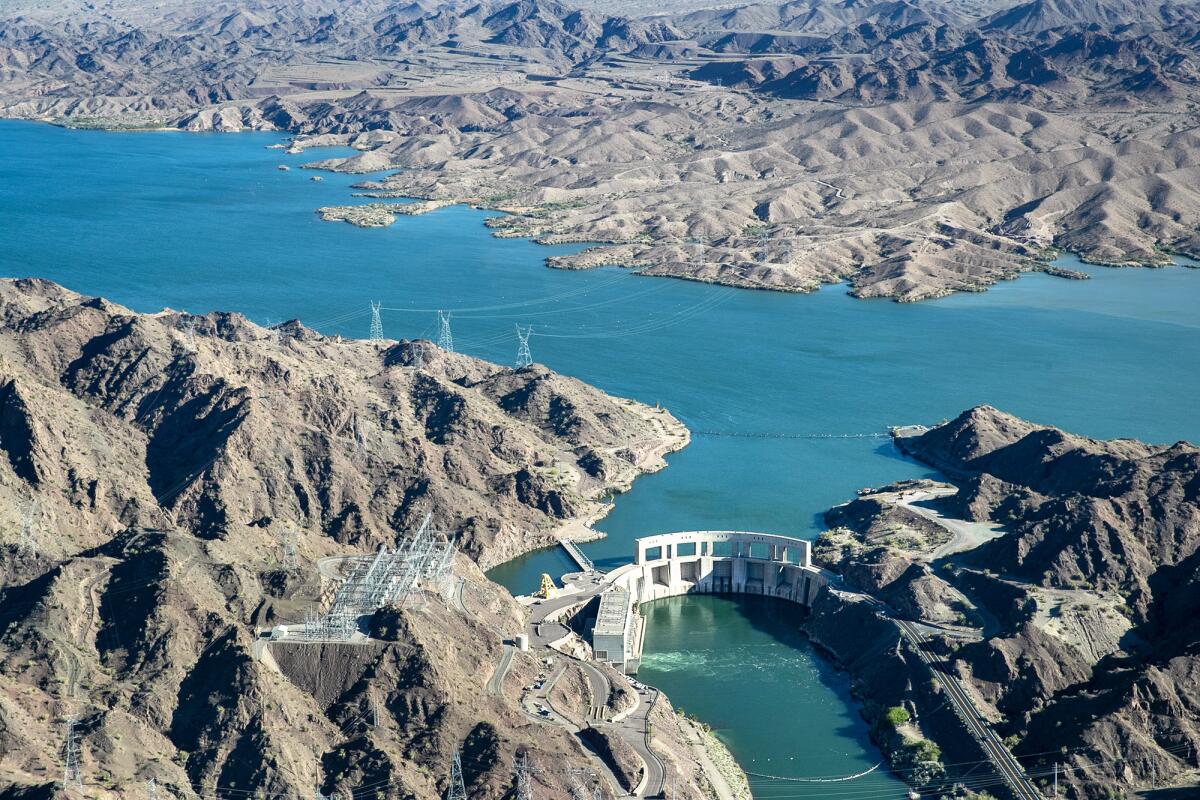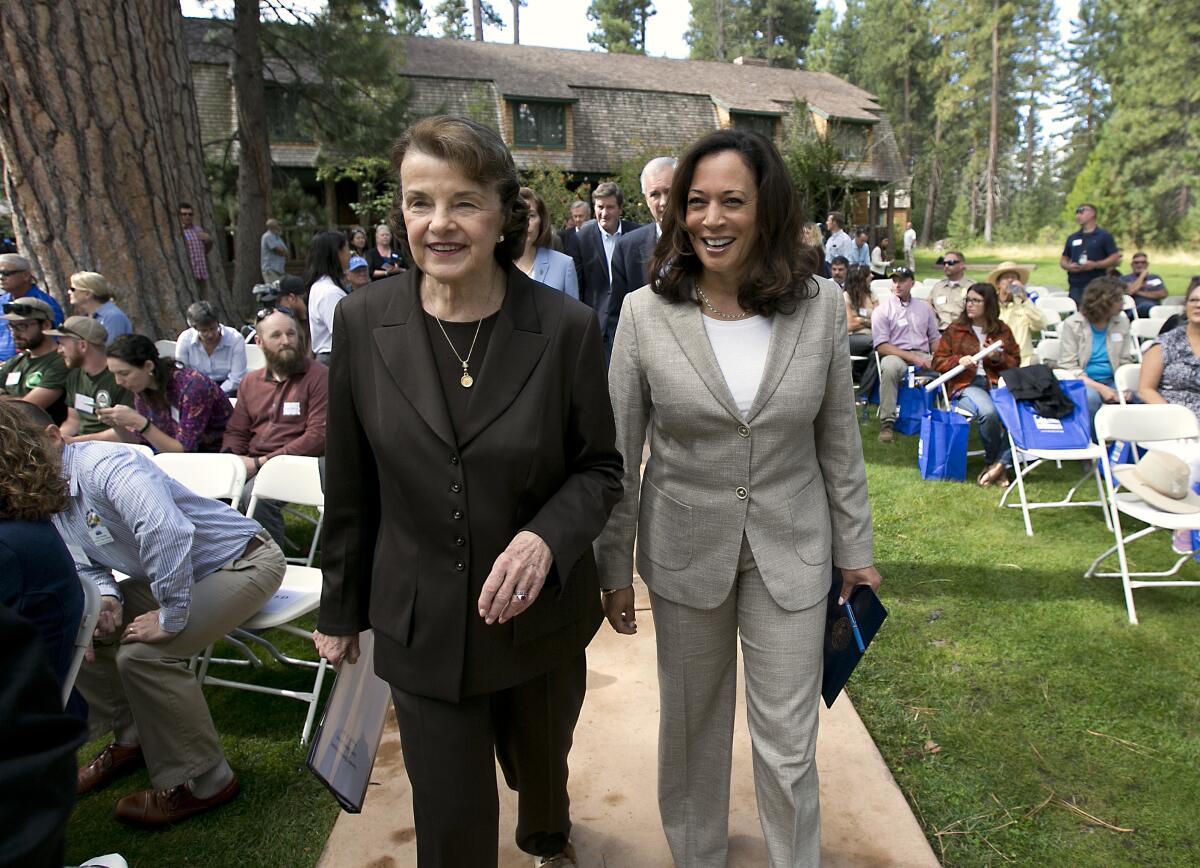Column: Green hydrogen or greenwashing? Mojave water scheme takes new twist

- Share via
Cadiz Inc. has been called a “zombie,” a “poison pill” and a scheme to “suck the desert dry” by draining a delicate groundwater aquifer north of Joshua Tree National Park and selling the water to wealthy coastal cities.
Now the political power brokers behind the California company have a new gambit. It involves one of the few climate-friendly technologies that might find favor with the second Trump administration: green hydrogen.
Two weeks before the election, Cadiz announced a deal to supply groundwater to Spanish developer RIC Energy. RIC would build a solar farm at Cadiz’s Mojave Desert ranch, 160 miles northeast of downtown Los Angeles, and use the electricity to split water molecules into hydrogen and oxygen atoms. The energy developer would sell the clean-burning hydrogen for combustion in cars, trucks and power plants, to replace planet-warming fossil fuels.
You're reading Boiling Point
Sammy Roth gets you up to speed on climate change, energy and the environment. Sign up to get it in your inbox twice a week.
You may occasionally receive promotional content from the Los Angeles Times.
Oh yeah, the icing on the cake — this week, Cadiz agreed to buy 180 miles of steel pipe from the failed Keystone XL oil pipeline, which was rejected by President Biden. Cadiz will use the pipe for its groundwater project, which it now says will be majority Indigenous-owned and largely supply water to low-income and tribal communities.
The news release announcing the Keystone XL deal includes a quote from Dave Archambault II, a former chair of the Standing Rock Sioux tribe who fought to stop a different oil pipeline from crossing the tribe’s reservation.
“I commend the Cadiz leadership for their vision of creating a better future for our children,” he said.
This is too good to be true. Right?
Let’s decide together.
Cadiz has a troubled history. In fact, acknowledging that history is part of its public relations strategy.
As a Cadiz representative told me himself, “Cadiz has had a checkered past.”
Stanley Young, formerly a California Air Resources Board spokesperson, also assured me Cadiz is “virtually a new company” now. Bemused but intrigued, I agreed to talk with Susan Kennedy, the firm’s new chief executive.

Kennedy is as politically connected as it gets in the Golden State — cabinet secretary to former Gov. Gray Davis, chief of staff to former Gov. Arnold Schwarzenegger, former member of the Public Utilities Commission. In case you’re not sufficiently impressed, she was also communications director for the late Sen. Dianne Feinstein.
“We have massive resources for clean energy development out at Cadiz,” she told me. “We have 45,000 acres of land with pristine, plentiful water and a massive amount of sun. So we can do green hydrogen at a very low cost, with access to pipelines and rail lines to be able to move the product into the Southern California market.”
“We’re the best place, I think, to be able to build hydrogen, clearly in the Southwest,” she added.
This is classic Kennedy — brash, boastful, confident. It’s no wonder she and Cadiz’s revamped board of directors — which includes a past leader of the California Environmental Protection Agency, a former advisor to President Bill Clinton, basketball legend Magic Johnson’s former business partner and L.A. Mayor Karen Bass’ current chief of staff — may come closer than anyone to securing approval to export groundwater from the aquifer.
To environmentalists, Cadiz is still the same environmental disaster it’s always been.
During the 20-plus years the company has been seeking permission to pump, sell and move water, conservation groups and and Native American tribes have pushed back in court and PR campaigns, arguing that groundwater pumping could dry up desert springs vital for wildlife including bighorn sheep, bobcats and migratory birds.
Feinstein, Kennedy’s old boss, was the firm’s fiercest adversary. She worked furiously to block its project, writing in a 2017 opinion piece with state lawmaker Laura Friedman that Cadiz could “destroy the Mojave Desert.”
For conservationist Chris Clarke — who hosts the 90 Miles from Needles podcast — the main problem with Cadiz is that it’s “so catastrophically wrongheaded to go to the driest place in North America as a source of water.”
He called the hydrogen deal the latest in a long line of “righteous-seeming fronts” dreamed up by the company to distract from its fundamentally problematic goal. They’ve included a training center for farmworkers — credit where credit is due — and a never-materialized steam train and museum meant to serve as a tourist attraction.
The reality, Clarke said, is that private investors want to profit by pumping and selling ancient groundwater from areas surrounded by beloved public lands, including Joshua Tree and Mojave National Preserve. And it’s wrong.
“They keep coming up with different flavors of metaphorical Febreze to spray on this thing,” he said.
To hear Kennedy tell it, every claim raised by conservationists has been debunked. She’s preparing to sell water to high desert communities through an idle natural gas pipeline running northeast, and to build additional pipelines to link up with the Colorado River Aqueduct, using those leftover steel tubes from Keystone XL.

Connecting with the 242-mile aqueduct — which carries Colorado River water to coastal cities — is key to Cadiz’s plan to serve as a “groundwater bank” for the Southwest. Cities and tribes would be able to store water in Cadiz’s aquifer during years when they have too much, without losing water to evaporation, like they do at Lake Mead.
They could also make trades. If Phoenix were to store water with Cadiz, for instance, it might pay L.A.-area water agencies to take some of the water during a dry year, in exchange for the L.A. agencies leaving some of their own water in Lake Mead — thus preventing Mead from crashing, and helping Arizona avoid crippling water cuts.
The result, Kennedy says, would be greater resilience to climate change, which is making the Southwest hotter and drier. Southern California also would be less dependent on water imports from the Sacramento-San Joaquin River Delta, which are decimating the Delta ecosystem and could be disrupted by a major earthquake.
“It becomes very cost-effective, and very beneficial to the environment,” Kennedy said.
Again: Too good to be true?
Charming Evelyn sure thinks so. She chairs the Sierra Club Angeles Chapter’s water committee, and when I asked her whether Cadiz could benefit the Delta ecosystem, she laughed and said, “I wish you could see my face right now.”
Southern California’s main water wholesaler, the Metropolitan Water District, already has lots of storage facilities, Evelyn noted — at Lake Mead, Diamond Valley Lake in Riverside County and underground in the high desert.
And Cadiz, despite the power players on its board, hasn’t broken through in Sacramento. Gov. Gavin Newsom has thrown his political capital behind other massive water projects, most notably the $20-billion Delta tunnel.
The environmental argument for Cadiz, Evelyn said, “is so far-fetched.”
“It just doesn’t gel, is the nicest way for me to say that,” she said.
One of the biggest obstacles facing Cadiz may be a California law, signed by Newsom, written specifically to stop the company from shipping water through the Colorado River Aqueduct unless the California State Lands Commission first determines its pumping “will not adversely affect the natural or cultural resources” of nearby public lands.
Kennedy insists this won’t be a problem — especially with Feinstein no longer in the Senate. She plans to submit a rock-solid environmental analysis to the lands commission showing no adverse impacts, forcing its hand.

And if the lands commission still says no?
“They’re not going to say no,” Kennedy said. “I am very confident.”
Like I said: brash, boastful, confident.
Cadiz’s success may depend on Kennedy’s decision to rebrand the firm as an environmental justice enterprise that can supply water to low-income communities and people of color, while also generating revenue for Native American tribes. Kennedy says the $800-million groundwater bank will be at least 50% tribally owned — a savvy response to the tribal opposition that has frustrated Cadiz in the past.
There are pitfalls, though, with this kind of strategy.
In January, for instance, Politico reported that labor icon Dolores Huerta was furious with the group Groundswell for using her picture to promote a Sacramento event that she felt was “co-opting the language of environmental justice” as part of a plot to gain approval for Cadiz. She described Groundswell as an “astroturf group” that “does not represent the water justice movement and seeks to pit organizations of color against environmental groups.”
“They’re using all of these groups of color to kind of be the face of what they’re trying to do,” Huerta said.
Maybe Cadiz can do some good for Western water supplies. Maybe this isn’t the same company as before.
But it’s hard to fully trust someone telling you they’ve got no problems whatsoever, and everyone who says otherwise is unassailably wrong. Especially when that person, by no fault of their own, is ultimately working for investors — the biggest of which is Dutch marine giant Heerema Group — who want badly to make a lot of money.
“This business model is very, very profitable,” Kennedy said.
And as for green hydrogen?
As I’ve written previously, it’s a valuable tool in the energy transition, not a catch-all climate solution. It should be especially useful for cleaning up industries where switching from oil and fossil gas to electric power is too difficult or expensive, such as shipping, aviation, cement manufacturing, steelmaking and possibly long-haul trucking.

Just don’t believe fossil fuel industry ad campaigns implying we don’t need electric cars, or solar and wind farms, because we can swap in hydrogen for coal, oil and gas in our passenger cars and power plants. And where we do use hydrogen, be sure to ask how it’s made: Is it being produced with fossil fuels or renewable energy?
On that last question, at least, Cadiz’s project gets high marks.
RIC’s proposal to build a gigawatt of on-site solar — plus another gigawatt-hour of battery storage, so as to keep making hydrogen even when the sun goes down — sounds great. The company would ship the fuel to customers via some combination of trucking, pipelines and the rail lines that conveniently run right past Cadiz’s ranch.
Also helpful: billions of dollars in planned federal funding for “hydrogen hubs” in California and other parts of the country, as well as hydrogen tax credits currently being finalized by the Biden administration. That money is likely to survive the Trump administration, considering continued oil and gas industry investment in hydrogen.
Did RIC have any concerns about working with Cadiz, given the company’s checkered past?
“In a development business, we’re used to a fair amount of opposition,” said Jonathan Rappe, chief executive of RIC’s North American operations. “We believe in the long-term environmental benefit of what we’re doing.”
But even though Cadiz says the hydrogen facility would use 500 acre-feet of groundwater per year at most — a small fraction of the amount the company ultimately wants to pump — it would still be coming from the Mojave Desert. Rather than, say, a wastewater treatment plant on the coast, near where the hydrogen would be used.
Is this the best place to make hydrogen, and to solve our water problems? Or is Cadiz too good to be true?
I’ve got my suspicions.
This is the latest edition of Boiling Point, a newsletter about climate change and the environment in the American West. Sign up here to get it in your inbox. Or open the newsletter in your web browser here.
For more climate and environment news, follow @Sammy_Roth on X.
Toward a more sustainable California
Get Boiling Point, our newsletter exploring climate change, energy and the environment, and become part of the conversation — and the solution.
You may occasionally receive promotional content from the Los Angeles Times.




